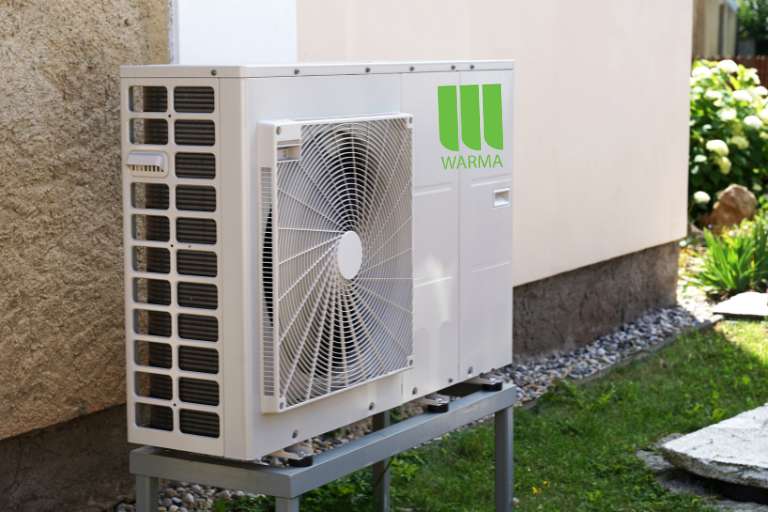What Are They? When do they work?
Firstly, we should establish what an air source heat pump is and what it does. Many of the people selling them these days try to impress upon their potential clients that they are the be-all and end-all of energy efficiency and that a heat pump is basically free heating, this is false. From this article you will learn; the basics of what heat pumps do, what they are and a little bit about whether a heat pump is the right choice for your home.
What is an Air Source Heat Pumps?
There are several different types of heat pump systems, but they all work on the principle that compressed coolant becomes hot and low-pressure coolant becomes cold. Let’s take a look at air-to-air heat pumps.

Air source heat pumps are becoming an increasingly popular choice for homeowners looking to make their homes more energy-efficient. However, there’s a lot of misinformation surrounding how they work and what they can realistically achieve. Some sellers claim they offer “free heating” or are the ultimate solution to reducing energy bills, but this is misleading. In this article, you’ll learn how air source heat pumps work, what they are, and whether they might be the right choice for your home.
How Does a Heat Pump Work?
Heat pumps come in several varieties, but they all operate on the same fundamental principle; compressing refrigerant increases its temperature, while reducing its pressure makes it cold. Air source heat pumps are among the most common and can be an energy-efficient way to both heat and cool your home.
Let’s explore how air-to-air heat pumps function in more detail. The diagram below gives a visual representation of what happens in an air source heat pump in heating mode.

The Basics of an Air Source Heat Pump (Heating Mode):
- Compression: The compressor raises the refrigerant’s pressure and temperature. This hot, high-pressure refrigerant is then sent to a fan-assisted heat exchanger inside your home.
- Heating the Air: A fan blows cool room air over the pipes filled with hot refrigerant, which heats the air and cools the refrigerant.
- Cooling & Expansion: The refrigerant, now at a medium temperature and pressure, passes through an expansion valve, lowering its pressure and cooling it further.
- Outdoor Heat Exchange: The cool refrigerant absorbs heat from the outside air, becomes slightly warmer, and then returns to the compressor to repeat the cycle.
In cooling mode, the process reverses: the heat pump absorbs heat from the indoor air and releases it outside, cooling your home.
Is an Air Source Heat Pump Right for Your Home?
While air source heat pumps can be an energy-efficient addition to your home, they’re not the perfect solution for every situation. To determine whether a heat pump is suitable for your needs, you should weigh the benefits and limitations based on your home, lifestyle, and local climate.
Key Considerations for Air Source Heat Pumps:
- Best for Moderate Climates: Air source heat pumps perform best in regions with mild winters. They can operate in temperatures as low as -15°C, but their efficiency decreases in harsher cold climates.
- Slower to Heat Water and Spaces: Heat pumps work at lower temperatures compared to traditional gas boilers. This means they take longer to heat water or spaces, and you may need to adjust your heating expectations.
- Works Best with Larger Radiators or Underfloor Heating: Air source heat pumps operate most efficiently when paired with larger radiators or underfloor heating systems that can distribute the lower-temperature heat effectively.
- Longer Heating Time: Homes with higher heating needs, such as larger properties or homes with many rooms, may find heat pumps take longer to warm the house compared to traditional heating systems.
How to Decide if an Air Source Heat Pump Is Right for You
To help you make an informed decision, let’s look at some of the key factors that will determine whether an air source heat pump can deliver the results you’re looking for.
1. Your Local Climate
Air source heat pumps extract heat from the outside air, meaning they work most efficiently in regions with mild winters. If you live in a place where temperatures regularly fall below freezing, your heat pump will need to work much harder to extract heat, potentially lowering its efficiency and increasing your energy bills.
Modern heat pumps are designed to work at temperatures as low as -15°C, but their efficiency will still be significantly reduced in extreme cold.
Conclusion: If you live in a region with relatively mild winters, an air source heat pump could be a great fit. If you experience long, harsh winters, you may want to explore a backup heating system or consider a ground-source heat pump, which is less impacted by external air temperatures.
2. Home Size and Insulation
Air source heat pumps are most effective in well-insulated homes where the heat generated can be retained. Homes with poor insulation will lose heat quickly, reducing the efficiency of the system. Additionally, these systems work best with larger radiators or underfloor heating, which are designed to handle the lower temperatures produced by heat pumps.
If your home lacks insulation, you might need to invest in improving it before installing a heat pump, as it’s essential for achieving the desired energy savings.
Conclusion: If your home is well-insulated and you’re open to upgrading your radiators or installing underfloor heating, an air source heat pump is likely a good choice. For poorly insulated homes, it may not provide the warmth you need unless you significantly improve your insulation first.
3. Hot Water Demand
Air source heat pumps can take longer to heat water compared to traditional boilers, and they work best when providing a steady, lower-level heat. If your household requires a large amount of hot water on demand—especially if you have multiple bathrooms—you may need to install a hot water cylinder to store hot water for later use.
Conclusion: If your household has moderate hot water needs and you’re comfortable with a system that provides consistent, lower heat, an air source heat pump will work well. If you require large amounts of hot water on demand, you may need to assess whether the slower heating time will meet your needs.

4. Upfront Costs and Long-Term Savings
The initial cost of installing an air source heat pump can range between £7,000 and £13,000, depending on your home’s size and the complexity of the system. However, many governments offer grants or incentives that can reduce upfront costs. Compare that to a traditional gas boiler where the price point is between £2,000 and £4,000.
Despite the initial outlay, an air source heat pump can save you money in the long term by reducing your energy bills. These savings will be particularly noticeable if you’re switching from electric or oil-based heating systems. However, in homes with high heat loss or extreme climates, these savings may be reduced.
Conclusion: If you’re prepared for the upfront investment and are focused on long-term savings, an air source heat pump could be a cost-effective solution. Research government incentives and grants that may help lower installation costs.
5. Maintenance and Lifespan
Air source heat pumps require regular maintenance to ensure they continue to function efficiently. You’ll need to schedule annual services to check refrigerant levels, clean filters, and inspect the system for any wear and tear. With proper care, these systems can last for 20 years or more.
Conclusion: If you’re comfortable with regular maintenance and want a system that offers longevity, air source heat pumps are a great option. A well-maintained system can provide reliable heating and cooling for two decades or more.
6. Environmental Impact
Air source heat pumps are one of the most environmentally friendly heating options available today. They produce far fewer carbon emissions compared to traditional gas or oil boilers and are a key technology for reducing the carbon footprint of homes. By using the heat in the air around your home, these systems provide a renewable, green source of energy.
Conclusion: If you’re committed to reducing your environmental impact, air source heat pumps are an excellent choice. They’re part of a larger movement toward more sustainable home energy solutions and are ideal for eco-conscious homeowners.
Is an Air Source Heat Pump Right for You?
Air source heat pumps offer an efficient, eco-friendly solution for heating and cooling, but they’re not right for every home. If you live in a mild climate, have a well-insulated home, and are willing to invest in larger radiators or underfloor heating, this system can provide significant energy savings and long-term environmental benefits.
However, if your home is in an area with harsh winters, poor insulation, or has high hot water demands, a traditional heating system or a ground-source heat pump may be more appropriate.
Before making a decision, it’s essential to consult trusted experts who can assess your specific needs. At Warma Heating and Plumbing, we can review your home’s energy requirements and help you understand the long-term benefits of installing an air source heat pump. With the right guidance and setup, these systems can transform the way you heat and cool your home, offering both financial savings and a reduced environmental impact.
Get in touch with Warma Heating and Plumbing today to discuss whether an air source heat pump is the right solution for your home. Our experienced team is here to offer personalised advice and expert installation.






